
Originally from the USA, my husband and I now live in a small cabin in the mountains of Sweden with our three kids.
I am a reluctant minimalist. Years ago my husband asked me to declutter, but I always had an excuse for why we couldn’t get rid of anything!
Minimalist living can bring a new level of calm to your family. When there are no longer piles of toys or dishes to get frustrated over mom and dad can relax and know that, even when the house is messy, the items in the home are easily managed and quick to pick up.
Because minimalists only keep toys that are loved and used regularly, kids won’t have decision fatigue when they decide what toys to play with. Those with Anxiety can find a new calm in a clean decluttered home. Minimalism benefits your whole family.
I spent considerable time in our storage room, the last couple of weeks, trying to get it decluttered, cleaned, and organized once and for all! I know I will have to quit bringing home unnecessary stuff if I want to keep it that way!
Annie
Our constant projects on our Swedish Farm have demanded decluttering, and deep cleaning as the whole family switched bedrooms, and we emptied 200 years of junk out of one of the outbuildings to turn it into a workshop for my husband’s business.
I was originally inspired to declutter when my son, who was 10 at the time, started throwing items out of his room! The pile got so big that I could not get to our only bathroom, and when I asked him what he was doing he said that he no longer wanted to have things in his room that he didn’t like and use. He went on to explain that he felt his ADHD less in a clean clutter-free environment.
That evening I sat on the couch and looked around my rather cluttered living room. The thought that struck me was, ”If having a decluttered bedroom made him feel his ADHD less then how would a whole decluttered house change his life?
That thought made me determined to declutter our entire 200-year-old farm (not a working farm) I was ready to tackle everything even the old outbuildings that were already filled with junk before we bought the property!
Just to clarify, we are not extreme minimalists. We do not live in a bare white box and fit all our possessions in a backpack! I like the terms ‘Family Minimalism’ or ‘Simple Living’ because it indicates that you cut out the excess and still have the possessions that your family actually needs.
Annie
(The photo of the chairs at the top of this section is by Photo by Eric Montanah. His name kept showing up on my home page saying that he took my photo when I credited him directly under his photo, so his credit is here until the theme can get the problem fixed.)
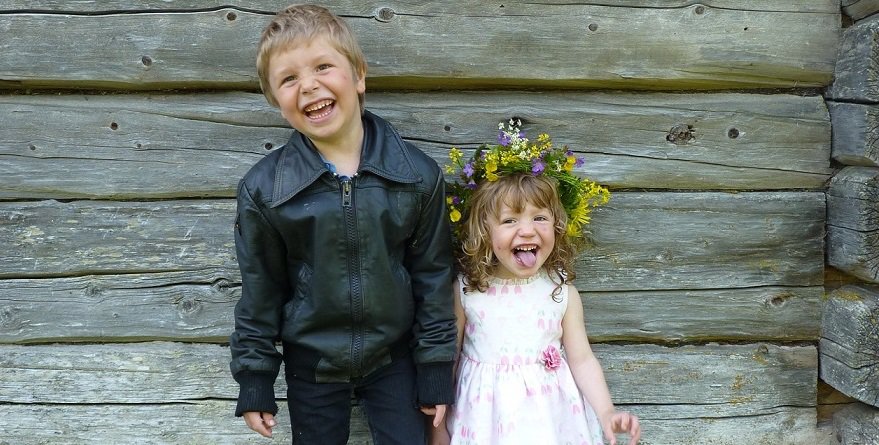
1) Minimalism can help you cope with diagnoses
I know that not everyone has a family member with a diagnosis, but many families suffer from overwhelm and decision fatigue. Minimalism can help everyone feel calmer and less stressed!
Having less stuff to manage helped me feel calmer and gave me the extra mental energy to deal with two kids who have ADHD and Dyslexia diagnoses.
Our son, Lage started decluttering his room all by himself. That gave me the extra push I needed to start decluttering the rest of the house!
Annie Eklöv
Lage threw his stuff out in the hallway one afternoon. I thought he was just reorganizing his room until the pile got so big that I could no longer get to our only bathroom! At that point, I poked my head in his bedroom and asked what he was up to.
He told me that he didn’t want extra stuff cluttering up his room any longer!
Being the economical parent that I am, I grabbed a couple of new clothing items off the pile and tried to convince him to keep them! This was a mistake, it immediately made him angry, but his response to my hoarding changed our lives!
”Mom,” he said, ”I can’t have junk that I don’t even want, cluttering up my room anymore! When I only have the things I like and need in my room I feel calmer, and I feel my ADHD symptoms less!”
He had been struggling with ADHD for years, both at home and at school. The thought that I could help him escape some of his ADHD symptoms by just getting rid of stuff was a huge motivator for me! Just a few weeks later I rolled up my sleeves and started decluttering.
Annie
This time (When I finally decluttered because I wanted to, not because someone else asked me to) I tried to be realistic about what we actually needed, and I got rid of many more things than I was previously willing to let go of!
Minimalism has been a gradual journey for me. I wish I could have just thrown out half my stuff without looking through it and done a quick restart, but unfortunately, I am not that kind of person.
I see the decluttering process as a spiral.
The first time I decluttered represented the biggest part of the spiral. I wanted to get rid of stuff, but I still kept a lot of items for ‘Just in Case’.
Each time I decluttered the spiral got smaller and smaller and I let go of more things as I went. Realizing that we hardly ever got out the just-in-case items freed me to let go of more items.
My goal is to get to that satisfying point in the middle of the spiral. The ”Calm Point” where you feel that you have exactly the right amount of items in your home for you!
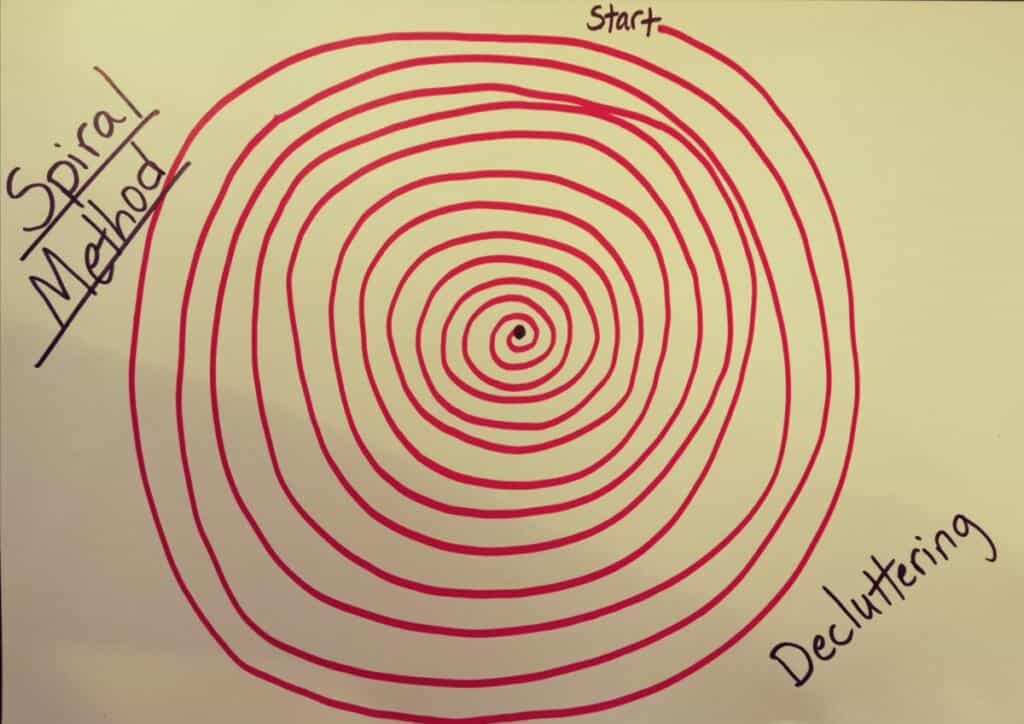
We are really close to this point in our house, but I am still wading through items in the storage room, selling on Ebay, and driving to the secondhand store! My son helps me keep my motivation up and get through those last cluttered areas!
Hopefully, I will get rid of the last circle of stuff soon because we have plans to renovate the building where we store our junk! I need to empty these spaces in order to start renovations!
If you have trouble letting go of things (like I did) read my other posts on decluttering How to let go of things, and deal with fears and Decluttering kids toys and other monsters in their rooms.
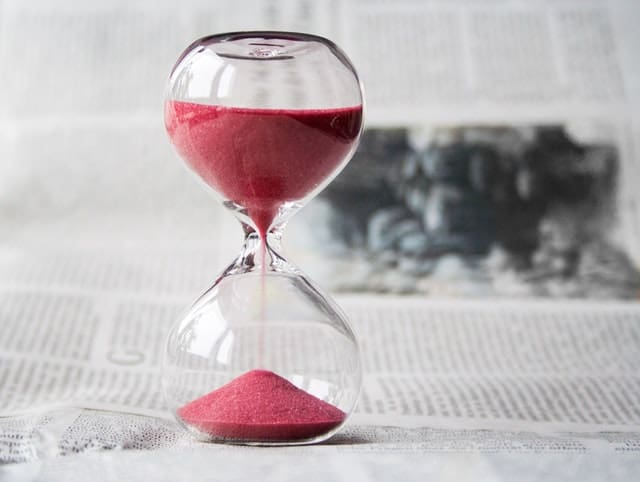
2) Minimalism Gives You the Gift of Time!
You can spend more time with your family, start a new hobby, or do that workout plan you always wished you had time for.
Yesterday I stood in the storage room frustrated by how much time all the clutter was costing me! I felt guilty for not spending time with my kids, and I was up to my neck in junk we hastily threw in the storage room when the Realestate agent came to appraise our house!
We are not moving, but we needed alone to fix our aging sewer system, which the city declared obsolete! Fixing the sewer system is a big project. Because we decided to upgrade and add a toilet to the guest house sooner rather than later (This saves us money in the long run) we needed a loan.
The problem with cleaning in a panic is that you don’t have time to make intelligent decisions.
You delay making many choices because you don’t have the time or the mental capacity to make split-second decisions about what to keep when you’re stressed!
Annie
I do know that I am spending far less time managing and organizing stuff than I did a few years ago!
I used to think the answer to our stuff problem was better organization. I spent loads of time trying to organize everything, and I got frustrated when my family couldn’t figure out my latest system!
Despite all my good organizing intentions I still couldn’t find the box of neutral newborn clothes when my second child was born! I knew I had expensive items in the box made out of wool and silk which had to be special ordered and I was frustrated when I couldn’t find what I needed!
I spent way more time looking for that box than was reasonable, and I ended up spending more time reordering some of the most important items! The box finally resurfaced four years later!

3) Minimalism Teaches Kids that Life is not About Getting Ahead of the Joneses.
If we let our kids grow up thinking, they always need to ‘One-Up,’ their neighbors, or that they need fancy things to show the world they ‘MADE IT,’ then our kids may chase fancy things, flashy cars, and bigger houses for the rest of their lives!
Annie Eklöv
Showing your children (or your sibling and friends if you don’t have kids) that ‘You can be content with what you have and comparing yourself to others is fruitless’ is a life lesson that teaches kids to think for themselves, to stand up for what they believe is right, and to go against the flow.

4) Minimalists Teach their kids that Experiences are worth more than things
Having good experiences together as a family gives your kids wonderful memories!
Growing up I sometimes compared what experiences cost to what an item I wanted to buy cost. I remember that on one trip we went out to eat at a seafood Buffe which was a bit more expensive than the places we normally ate, and I sat there thinking that the meal was about the same price as an expensive doll I wanted to buy.
My parents bought me the doll I wanted for my next birthday, but my joy over my new acquisition was short-lived. Years later, I still have fond memories of the family trip we took, but my interest in dolls waned.
Researchers at Stanford found that just seeing pictures of items that you want or plan to buy activates dopamine receptors in your brain. The problem is most of us get a kick out of the ‘Anticipation of the HUNT’ and the joy of the actual purchase is short-lived often followed by guilt!
Having positive experiences with your kids encourages family bonding and can be a great source of dopamine for years to come!
Annie
Brain scans now show that dopamine is released when we remember important moments in our lives. Thinking about positive memories can release dopamine for years (It also strengthens and solidifies our positive memories!) while thinking about spontaneous purchases often makes us feel guilty.
In the long run, positive memories do more for our mental health and wellbeing than any new item ever could!
(Source) “Novelty-Sensitive Dopaminergic Neurons in the Human Substantia Nigra Predict Success of Declarative Memory Formation” was published in the journal Current Biology.
(Source) https://www.ncbi.nlm.nih.gov/pmc/articles/PMC4254527/

5) Minimalism Helps put Money in Perspective
Just because you can buy something doesn’t mean you should.
Teaching kids (and others in your inner circle) that having the money to buy anything you want doesn’t mean that buying excess items is the right thing to do or the socially responsible thing to do.
- The large-scale production of almost all new items pollutes the environment, uses extreme amounts of energy, and often uses large amounts of water.
- Then there is the question of if it is possible to dispose of the new items you buy in an environmentally friendly way.
- The problems that new items pose to the environment are only one aspect of the problem. The western world’s demands for more and more items (or food) at lower and lower costs puts people’s lives in danger.
Trips to Nepal, India, Cambodia, and Thailand, taught me that slavery is alive and well even in the 21 century! The lack of jobs in Nepal forces young men to work in other countries where their passports are often stolen by their employers!
They can not leave their jobs and go home. The horrible working environment in many jobs literally sends men home in a coffin! We need to ask ourselves how items are being produced before we buy them!
Annie
There are children forced into labor in many countries, and men and women work in conditions hazardous for their health as they work unprotected among pesticides, material dyes, and other harmful industries. In many countries, there is little or no thought given to the safety of employees.
To help encourage ethical treatment of employees, you can buy fair trade products whenever you can, and if many of us buy used items instead of new it’s much better for the environment.
Many people, making small changes, can make a big change!
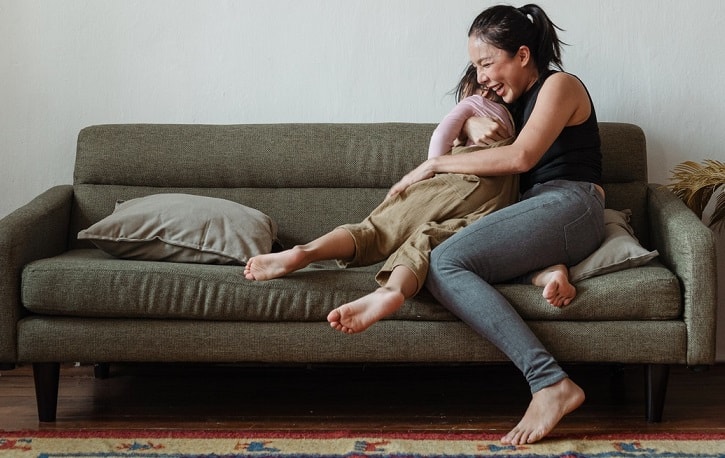
6) Minimalist show their kids that People are more important than things
Did you ever have the feeling when visiting someone’s home that the things in the home were more important than the people in it?
If everything in your home is so precious that no one can touch it your child (Children) will grow up feeling like everyone and everything is more important to their parents than he/she is.
No matter if you are rich or poor make sure you spend quality time with those closest to you.
No matter how careful we are, at some point, our kids will break things that are important to us. Don’t make the mistake that I did and become angry over broken items.
Annie
I got really upset at my son once because he didn’t listen when I asked him to stop kicking a ball in the house. He continued kicking, and he broke something important to me. I kept a special figurine high up on a shelf to keep my children’s hands off it, but nothing in our homes is really completely out of reach.
His reaction to my frustration taught me a lesson. Things are just things. We can not take them with us when we die. Many of our ancestors have tried and failed! My relationship with my son was far more important than any item in our home!
It took years to completely repair the damage my angry words caused that day. For several years he thew that experience in my face if I needed to correct him.
If we as parents and guardians change our mindset about the items in our home (hopefully before you yell at your kids) and truly consider the people in our lives to be more important than things we can avoid years of apologies, and or broken relationships.
Annie
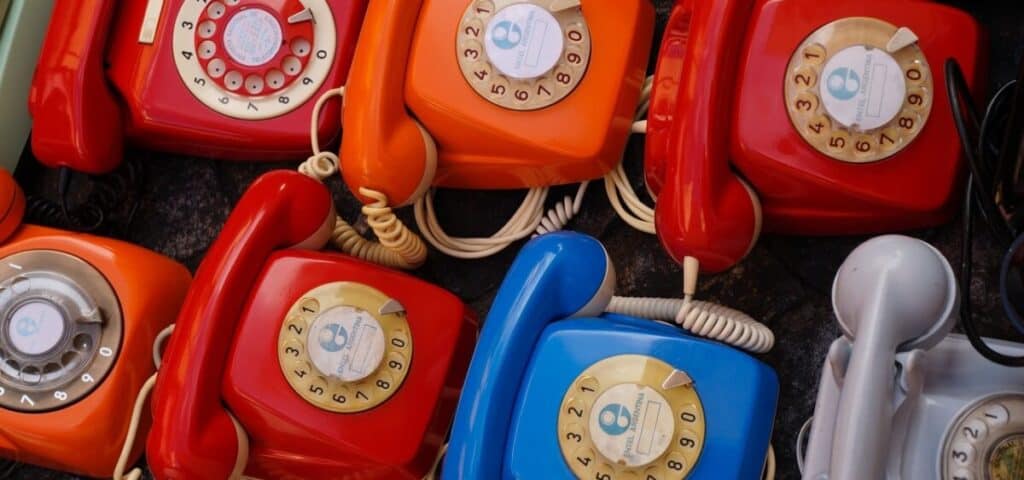
7) As A Minimalist, YOU CAN FIND What You Own (You will stop buying duplicates)
I can’t count how many times I bought duplicates over the years because I could not find my ‘Just-in-case’ items! It frustrated me to no end that I had to rebuy things I knew I already owned!
Reducing our inventory by 60% (which is about how much we have decluttered so far) has helped us tremendously. We are now able to find most things when we need them.
Annie
I am still not done decluttering, I have to finish clearing out our storage room, and I need to organize and label everything we are keeping. I don’t want to waste time looking for lost items any longer, and I don’t want to waste money rebuying things that I can’t find!

8) Minimalists let stores function as their ‘Storage Unit’
If I am going to rebuy things because I am unorganized, and I have too much inventory then I may as well leave the items in the store!
Annie
I can buy items when I need them and let the store, store the items for me. Whatever the cost is, when I need the items, it is guaranteed to be cheaper than renting a storage unit, even after inflation!
If we consider that time is money, storage units cost money, and every inch of our home that we can’t use due to excess stuff costs us money, we may think twice about the free option of allowing the store to function as a free storage unit!
Annie

9) Minimalists don’t panic when the house is a mess
Minimalist homes don’t get as messy as the average American home does. Because Minimalists have less stuff in their homes, their homes can’t get extremely messy!
I know I have had several experiences, before minimizing our possessions, where the kids decided to get out all their toys and mix them on the floor!
If this had been the only mess I may not have panicked, but the dished had piled up in the sink, the laundry was not done, and my daughter wet the bed.
Things needed to be washed before she could even go to bed that night!
I felt like the children in the book ‘The Cat in the HAT’ when their mother was walking up the drive and the house was so messy the kids started to panic!
The kids had a mess in the house ”So big and so deep and so wide they could not pick it up if they tried!” paraphrasing Dr. Suese.
Looking at my messy house made me feel like feeding my kids and putting them to bed was an insurmountable task!
The Good news is that after getting rid of loads of toys and stuff I don’t panic like that anymore!
Annie Eklöv
Thankfully I never feel anxiety like this over the house anymore. If the house is a mess it’s not anywhere in the vicinity of how easy it was when I felt paralyzed and paniced by the mess.
Even if my house is a mess I know that it won’t take long to pick it up and I can usually have the house looking great in an hour or two.
If I glimpse my neighbor on her way down the drive a 10-minute pickup does wonders!

10) Minimalists think twice before they buy which saves money
Cutting out impulse buying, which often leaves us feeling guilty, saves money.
Ways to stop impulse buying
- Don’t shop when you don’t need to buy anything (Don’t window shop).
- If you really want to purchase something that is hanging by the checkout counter or find a spur-of-the-moment sale, force yourself to take a step back and wait. If you are willing to leave the store without the item, you will know if it’s important enough to buy, if you are willing to drive back to the store and buy it a couple of hours later. At that point, you will have had sufficient time to think through the purchase. When I do this I often don’t think it’s worth driving back to get the item.
- Make a list of items you need to buy at the store and stick to the list!
- Stay out of the areas in the store that do not have items on your list. Keeping myself away from temptation is half the battle.
- If you mess up and regret a purchase, be willing to take it back.
- When purchasing items online let them sit in your online shopping cart for 24 hours before you buy. This helps you think through what you actually need.
- Don’t let your computer save the info on your credit or debit card. You will be surprised how huge a hurdle getting off the sofa to retrieve a debit card can be! I have given up on purchases because I didn’t want to get my card and punch in the numbers. If that’s the case, the purchase was not that important!
- Don’t be fooled by free shipping when you need to buy a certain number of items or if your items are worth a certain amount of money!
- I have on occasion fallen into the free shipping trap. I bought an item to get free shipping only to get the item home and be extremely disappointed at the quality or I bought clothes for one of my kids which did not fit and needed to be sent back. I then paid the same shipping fee in return shipping! I had to repackage the item, register a return on their homepage, drive the package to the store, remember to get an official receipt and pay to send it. At that point, I would have saved time and gas money to pay the original shipping fee!
- I have at times bought an item to get free shipping when I was 10$ short of reaching the limit for free shipping, and my shipping costs were 10$ or more, but I looked through the store carefully and bought something we needed or were already considering buying. In my case, I bought underwear for my daughter for 10$. She needed it and it was roughly the same price as the stamps!
- Often we get sucked into buying something we don’t need to want just to get free shipping! Often the cost of shipping for items that you really need is less than the cost of storing items you don’t really want and easier than the hassle of sending items back.

11) Minimalists know when to let go of a hobby or sport they no longer enjoy.
Many of us have hobby supplies or sports equipment cluttering up our homes and garages. If you use it regularly that’s one thing, but we often move on to new activities or hobbies and leave the old ones to sit in the storage room because we think we will revisit the old hobby. Often our new interests take up so much time that we don’t revisit our old interests. We grow and change during our lifetimes, and our things need to change with us.
I like to sew.
I haven’t sewed much the last year because I have been writing this blog.
I still want to sew some outdoor clothing for my youngest because I have incredibly hard-wearing, high functioning, material in my closet.
I realized today (When decluttering my storage room) that I don’t need half of my inventory! I have material, buttons, zippers, and patterns, etc.
I don’t need as much sewing stuff when I am not spending the time on sewing that I used to.
My older kids are 14 and 11 and they no longer want to wear homemade clothing, even if I am an accomplished seamstress.
It’s time for me to get rid of some material that I bought to make my oldest pants. He has ADHD and had sensory issues with clothing as a child. He refused to wear bought pants!
I finally designed pants with him that he actually wanted to wear! I sewed these pants for him for 2.5 years, and I still have some material that I bought to make him more pants! He is 14 now and has been wearing off the rack pants for the last five years.
At the time I bought the material, I had no idea that he would suddenly start wearing bought pants again! Since I did not find any other use for the material after 5 years, It’s past time for me to let someone else enjoy sewing something out of it.
Annie Eklöv
We all have different periods in our lives and we need to understand what we actually need during these different times! I sewed a lot for the kids when they were little. I made their sheets and blankets and lots of clothing when they were babies, but those days are gone.
Until I have grandkids I probably won’t sew many kids’ clothes. If I give away some material (that will probably be out of style when my kids have kids) I can pick out something from the store that I will actually want to use when I need it!
This frees me from feeling obligated to use something I already have. If my daughters want me to make them some baby things, when they have kids, they will want a say in what material I use. Trying to convince them to use a material that I already have, that no one likes, will only result in wasting my time sewing something no one wants to use!

12) Minimalists buy quality over quantity
Quality over quantity can actually save you time and money.
When I buy higher quality children’s clothing, in colors that don’t get immediately stained, it often costs me less than when I bought cheap multiples of the same item, which often became stained or riped immediately.
Annie
This year I bought my daughter two pairs of winter ski pants. We live in the north of Sweden, and she wears these pants every day to school for at least 5 months of the year. She can come home wet and if we are going to ski or be outside in the evenings she often needs an extra pair.
I bought one pair of pants that were used made by a well-known high-quality brand. These ski pants lasted all winter and she was warm and dry in most weather.
I then wasted money buying a cheaper pair of ski pants new. these low-quality pants worked well for one month. At that point, they got a hole in the knee and after that, she was always wet.
I had to buy yet another pair of high-quality winter pants to replace the cheap ones!
I would have saved money, in the long run, and had a dryer daughter if I bought a very expensive ski pant new that my youngest could later interit, or that I could sell after one winter for a high percentae of the original price.
The money I spent on a cheaper pair of ski pants was completely wasted. She didn’t want to wear the extra pants, and no one else will either. They are not even worth saving as extra clothes for my youngest.
I had to buy an extra pair of high-quality gently used ski pants halfway through the winter season. This would have been avoided if I had just made a wiser purchase from the beginning.

13) Minimalists buy classic clothing in bold patterns or Basic colors that aren’t easily stained
I do like color and pattern, and I have a crazy wardrobe full of retro items, but many of these pieces I consider classics and many bold patterns can work just as well as dark colors at hiding stains!
Tips for a long-lasting wardrobe
- Buy clothing with bold patterns. Patterns hide eventual stains.
- White items can often be bleached if they are stained, but the items need to be all white.
- A great way to add color to white clothes is to use colorful broaches. Many of us have broaches from our grandma or great-grandma. These items are treasured best if they are actually used.
- Dark items in black, navy, dark purple, dark brown, and wine red are not easily stained.
- Make sure that the clothes you buy can be washed reasonably. Always read the label before buying.
Tips for brightening a minimalist wardrobe
- Fun modern broaches can be bought at a jewelry store.
- You can make broaches yourself out of colorful fabric if you buy the pin from a craft supply store. If you can imagine it you can make it! A little hot glue does wonders!
- Jewelry is another fun way to brighten up any outfit. Jewelry for children, if worn around the neck, should have a clasp that opens easily if caught in a tree branch (or other objects), or elastic that easily breaks to prevent suffocation.
- Scarves are a fun way to look classy or give a nod to retro.
- The safest way to add color to a child’s wardrobe is to use fun hair accessories and bracelets to brighten up clothes in solid colors.

14) Minimalists use family heirlooms in their everyday lives!
My Grandma collected teapots and she let me pick out the three above. She literally had hundreds close to 300 I believe! I have these out on a shelf in my home and we enjoy looking at them. They remind me of her.
I am very glad that she let me pick out the teapots that matched my home decor, and that I did not inherit 300!
My grandma is now 93 and in the process of disposing of excess items with the help of her daughter. She is essentially ‘Swedish death cleaning’ in her own way.
150 years ago, most people only had a few family heirlooms. Often the heirlooms were handed down from generation to generation and were; the family Bible, a wedding dress or veil, and the few things they owned worth real money.
During the 40s 50s and 60s goods became cheaper and many items became mass-produced. The result of this overabundance of goods for sale and sometimes on sale, if the company produced more supply than was on-demand, was that the average home in the western world now housed more ‘Heirlooms’ than ever before!
We can only take care of and treasure a limited number of possessions.
Annie Eklöv
At the end of the 1800s and the beginning of the 1900s inheriting your parent’s farm (or house + business) and all the stuff that went with it was often a blessing, not a burden! Back then the family house and barn were not overstuffed with nonessential items. Often families barely had what they needed!
It was essential for children to inherit because children from poor families did not have the money to buy their own farmland and their education did not allow them to choose from several professions.
Inheriting something or being given an item was a blessing.
If you compare that to life today when children leave their parents home get their own well-paying jobs, buy a house, and fill it with children and excess belongings only to inherit their parents home which is overstuffed with belongings when their parents die!
Having to sift through the junk and find the few truly valuable family heirlooms is a huge chore! This is exactly why the Swedes suggest ‘Swedish Death Cleaning. No child wants the burden of 90 years of unsorted possessions when they need to sell an extra house!
I challenge you, to only keep family heirlooms that you can enjoy and use (or look at if it’s art)!
If it has to be boxed up in the basement most likely it will only be a burden you pass on to your kids!
Annie

15) Minimalist don’t tote shuffle
Tote shuffling is referring to moving items around that you delay making decisions about.
For instance, I spent the last decade moving excess items around. I thought that my family was more secure because even if we didn’t have a lot of money we had a lot of useful stuff!
I moved items from one storage room to another and spent time organizing them over and over again, only to find that when I needed something I still couldn’t find it!
Annie Eklöv
It wasn’t until I realized how much time all this stuff was demanding of me that I began to ask myself why I had accumulated so much stuff! I had filled our entire gust house with so many items that we barely had room for our guests! It didn’t stop these I filled a couple of small buildings on our farm ( approximately 30-45 feet squared) almost to the brim as well!
We live on a farm from 1790 (no longer a working farm). There are several outbuilding around the house. We actually live in a relatively small barn (smaller than the average Swedish home and extremely small by American standards!). The log barn was taken down and rebuilt by my husband’s parents.
Our guest house is the original farmhouse which still doesn’t have any running water. It has more square footage than the barn we live in, but renovating it (from the foundation up) is an enormous task that we haven’t felt ready to tackle while we still have small children.
One of the definitions of hoarding according to Mirjam-Webster is, ”the practice of collecting or accumulating something (such as money or food)”.
Other dictionaries added that these items are to be used in the future and that the people collecting them have an extremely hard time letting go of anything.
If you consider the five stages of hording I could have been considered a very oranized stage 1 hoarder. Stage one hoarders have a smaller amount of stuff.
Realizing that all this ‘Moving of Stuff’ was taking time away from family and friends slowly helped me change my attitude towards things.
When my son expressed a need to have a clutter-free environment because it helped him with his ADHD I finally rolled up my sleeves and started finding new homes for my hoard!
Annie Eklöv
This wasn’t easy and it has taken me several rounds on my spiral to get to where I am today. I started out by letting go of things that felt ok to get rid of, and I slowly strengthened my decluttering muscles which allowed me to get rid of more and more things.

16) Minimalists don’t hurt their backs lifting and moving unnecessary furniture, and boxes
The last two weeks I have been busy decluttering the storage room. After lifting numerous boxes, and building supplies I found myself warming a hot water bottle to ease my backache!
I hope to get rid of our excess things once and for all, so I can quite moving things around. It not only hurts my back, but it’s also a colossal waste of time!
The only way to quit moving items around your storage room is to declutter, and limit the number of new items that enter your home!
I have to be careful when I am in town not to let one purchase lead to several other purchases.
Denis Diderot was a french philosopher who lived during the 1700s. He observed and wrote about how adding one new item to a home often led to several other purchases. This became known as ‘The Diderot Effect’
For instance, if I were to purchase a new sofa, I may find that the new sofa makes my coffee table look old and shabby, so I replace that as well!
Often this effect won’t stop after two purchases. I may not be satisfied until I replace the armchair, rug, and curtains as well as the sofa and coffee table!
This social phenomenon is just as prevalent today as it was in the 1700s.
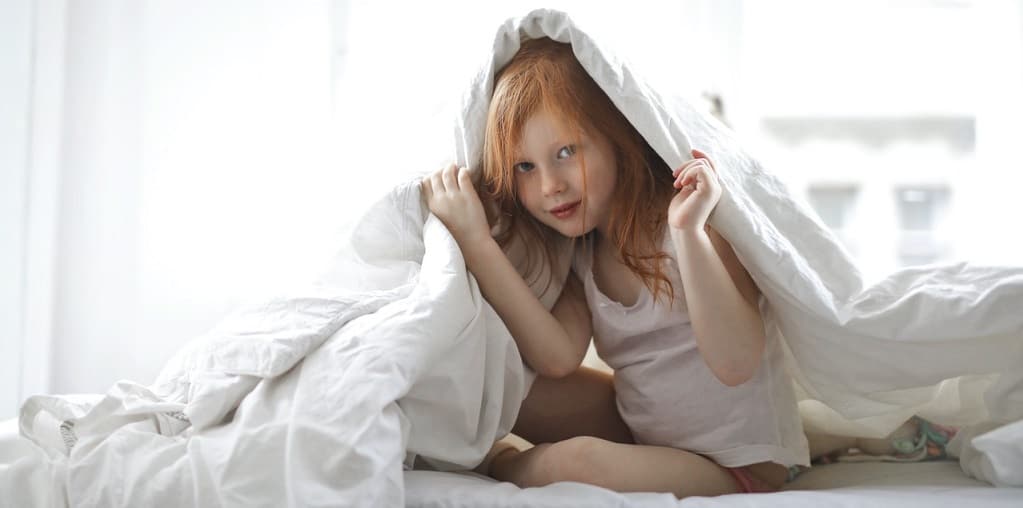
17) Minimalists don’t use excess stuff as a security blanket
When I first started decluttering, several years ago. I realized that I had several boxes of kids’ clothes in every size waiting for my youngest to grow into! Most of the items my oldest two children had grown out of or I received as hand-me-downs from older cousins.
I easily had 3 times more clothes than necessary! The clothes wouldn’t fit in my daughter’s drawers even if I tried packing them in like sardines!
At first, it was hard to get rid of anything, but when I realized that I was holding on to the items like a security blanket I was finally able to let go.
I didn’t come from a rich family, and growing up I often had to shop at second-hand stores to renew my school wardrobe. Because I never knew if or when I would get new things, I often held onto clothes that I didn’t like to wear for ‘Just-in-case’. When I realized that I was still doing this as an adult, I could finally get to the root of the problem.
I had to ask myself, what the worst-case scenario was if I let go of extra clothing, and suddenly needed some for one of the kids.
We didn’t have an enormous nest egg for emergencies when I began questioning my motives for keeping things. I had to look at different ‘Worst Case’ scenarios and think about what could happen in order to convince myself to let go.
Annie
Since I was having a hard time letting go of kids’ clothing I limited the emergencies in my scenarios to needing expensive items of children’s clothing at the last minute.
Moving to Sweden in 2004 was an eye-opener. In Sweden, parents often buy quality over quantity, and quality winter clothing for kids is expensive.
I had to ask myself what would happen if we needed to buy winter clothes for the kids, or winter shoes for my oldest who had enormous feet, and it costs hundreds of dollars?
- Winter boots cost around 100$
- High-quality kids winter overalls cost around 170$
- Winter pants from a well know high-quality brand cost 150$
My conclusions were as follows:
- Most likely I could find high-quality used winter kids clothing even at the last minute.
- We could afford to buy my son new shoes even if it was a bad month.
- If we suddenly had several emergencies at once, we could sell things, borrow money from a relative, or increase the loan on our house.
- I could pick up more hours at work if we were in a pinch (I was only working part-time).
- We were saving every month, so our emergency fund was increasing.
- We had a safety net of friends and relatives that we could ask for help
One of the results of all my decluttering and questioning was that we started saving a set amount of money each month. Knowing that our emergency fund was growing helped me to let go of even more things.

18) Minimalists think like A Swedish Death Cleaner when they declutter sentimental items
Minimalists don’t put off hard decisions about their things or leave everything for their kids to wade through when they are gone.
I recently tackled one of the hardest rooms in my storage room. I kept opening boxes of sentimental items! The mindset of Swedish Death Cleaning helped me get through my sentimental items much quicker and easier than ever before!
If your just getting started, leave your sentimental items for last! It will be much easier to declutter sentimental items after you have practiced decluttering the rest of your home first!
I know! I tried decluttering sentimental items at the beginning of my minimalism journey, and I didn’t get rid of much.
I am in the middle of decluttering sentimental items again, and I can tell you I am getting rid of many more things this round, and I feel really good about it!
Annie Eklöv
When I tackled my sentimental items, these were the thoughts I kept in the back of my mind.
Sentimental Papers
- Will my kids actually want to read the letters, cards, emails, journals, etc when they are grown?
- Will the amount of written material make them overwhelmed and keep them from looking through any of the cards, journals, etc that I save for them?
Papers I kept
- I only kept cards with meaningful texts from people the kids know (For example, from their great-grandma who died yet they still remember her).
- I only kept the absolute best papers, letters, and cards.
- I put some cards and letters in each child’s sentimental box.
- No one will get a huge box of sentimental papers, but I hope that they will actually read the papers I saved for them.
I don’t suggest keeping too many sentimental papers for your kids to go through.
- I was given a whole box of loose papers, and it felt so overwhelming to go through that I still haven’t done it.
- My father was given papers and sentimental items from his school years, and he threw the whole box away!
Baby Clothes
When going through baby clothes here are some basic guidelines.
- Get rid of anything that has a stain.
- Stains can show up years after you packed up your precious baby items! I ended throwing out 1/3 of my daughter’s baby clothes because she spit up a lot, and her clothes got yellow stains while in storage!
- I tried all the methods I could find to get rid of the stains on a couple of outfits and nothing I tried worked! I tried everything from my grandma’s remedy of lemon juice and leaving it in the sunshine to special stain removes from the store. Nothing helped. do yourself a favor and just get rid of it. Your kids are not going to put your grandkids in stained clothes.
- Get rid of anything that you can no longer remember your child actually wearing!
- I went through my kid’s boxes of baby clothes several months ago and I couldn’t remember my oldest two kids in several of the outfits I saved. My oldest is 14 now. It was many years ago he was a baby.
- I gave myself permission to give away any outfits that I no longer remembered. I figured that If I didn’t remember them they weren’t that important.
- Take a new look at any items you saved because your child made them.
- Is the item whole? I threw out several wooden things my son made because they were broken and not worth fixing.
- Is the item made out of anything that will quickly deteriorate or collect bugs? Kids’ art made out of macaroni, gingerbread, or some kinds of clay can attract bugs and will often deteriorate before your kids are old enough to want their sentimental items.
- Is the item something your child is very proud of and will want to see again, or something they are not proud of and would rather not see?
- It can be helpful if you can remember your child’s reaction when they brought home the items.
- Is the item something your child will cherish as a grown-up or will they throw it in the trash after 20 years of your storing it for them?
I asked myself these questions and make new assessments of the items my kids made. Many of the items ended up in the trash. I kept a few items that were really tip-top and that could be fun to have/use as grown-ups.
Most of the stuff cluttering up our homes are not items that our children will be glad to take care of when we die!
One of the best gifts that we can give our kids is to only leave them things they can easily and gladly take care of when we pass on.
It’s worth sitting down to have a conversation with your kids about what they value when they are old enough.
Annie



